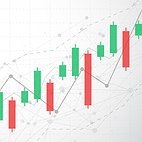It seems that every first time trader and a lot of experienced ones believe in the magical price forecasting power of the technical analysis. It looks very easy and creates some kind of magical thinking: take this price point, take another one, connect them – and here you go – you have a trend and this means that we all now know where the crypto is heading; look at this candle figure, check this indicator – now you know when to buy or sell. But let’s see if it’s really that easy.
To keep it simple, there are two basic approaches to analyzing financial markets: fundamental analysis and the technical one. While the former takes into account fundamental factors influencing business success such as the macro and microeconomics, financial reports, news about regulations, new products and hirings, etc., the latter looks only at the stock or token price movement in past and present time, using this data to forecast future trends.
Technical analysis is based on the following three principles:
- Efficient market hypothesis – the market price of an asset that always reflects all relevant information including fundamental parameters. It implies that all you need to take into account to analyze the project is its historical price movement.
- Market price moves in trends and is more likely to continue a past trend than move unpredictably. Most technical analysis instruments and indicators are used to identify where such long-term and short-term trends start and end.
- History repeats itself. Current traders mob is led by the same emotions, not always rational, as past traders. It means that the balance of FUD and FOMO tends to create the same trading patterns over and over again.
So what do these three principles have in common? They all rely on the following assumptions:
- Regulators are doing a good job preventing price manipulations and insider trading (though strong efficient market hypothesis says that market takes note of the insider information)
- The current market price is firmly established by supply and demand of a large amount of institutional and private traders and investors.
- Asset pricing makes use of fiat currencies for the exchnage means. Market price of such currencies also relies on the previous two principles.
- There are enough data points for analysis.
Crypto market is different compared to traditional markets. The absence of any trading regulations created Wild West environment with almost no rules, especially at the crypto to crypto exchanges with no fiat trading pairs. It means wash trading to create fake volume, pumps & dumps, front-running and all sorts of manipulations are very much real at almost any exchange, even the well-established ones.
There are no big institutional players in 99,9% of crypto. The biggest players are exchanges and projects themselves. Retail investors who bought tokens during ICO’s tend to hodl which makes real liquidity very low even with millions of fake daily trading volume generated. Real buying support within a 10% range from market price is more than $1m only for 30 coins and tokens, and more than $1k for 175 crypto assets. This includes liquidity generated by real traders and algorithmic bots from all the major exchanges where tokens are listed.
The hard truth is that a major part of tokens are totally illiquid. No surprises that you can significantly affect the price using just 1 thousand dollars or in some cases buying out the whole order book. And honestly, why on Earth should a project that exists as an idea on a white paper with no working product whatsoever, should be liquid and generate millions of dollars in daily trading volume when real Tier-2 and Tier-3 stock on traditional markets sometimes generates less?
The overwhelming majority of crypto assets is issued using the ethereum blockchain as ERC-20 tokens and traded against ether, while ether price is defined by USD. This means that ETH fluctuations multiply evaluation of ERC-20 tokens, which dramatically affects tokens/USD charts, technical figures, and patterns.
Different exchanges have different prices for the same trading pairs. For example BTC/USD price in January 2018 was up to $2,000 higher on some exchanges than the global average. Different prices make different charts and different pattern figures so technical analysis results can vary from one exchange to another. Also as Dow’s theory states, trends should be confirmed by the rising volume.
One of the biggest crypto exchanges in the world – Binance, with the biggest volume, hence the most ability to confirm trends, was opened in October 2017 and exactly one year of data is only relevant for the oldest listed cryptocurrencies. Most of the assets have even less history than that.
All these reasons, in my opinion, make the technical analysis useless for crypto. Some would argue that it has nothing to do with bitcoin, which has a lot of investors, real liquidity, volume, enough of averaged data points and we can close our eyes on potential manipulations.
Even if it’s true, all the things mentioned above would remain also true for the thousands other crypto assets.



